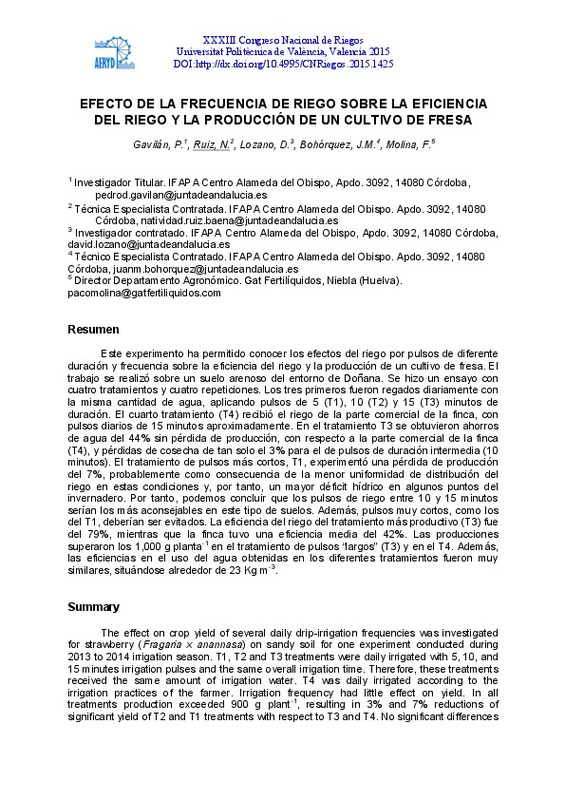JavaScript is disabled for your browser. Some features of this site may not work without it.
Buscar en RiuNet
Listar
Mi cuenta
Estadísticas
Ayuda RiuNet
Admin. UPV
EFECTO DE LA FRECUENCIA DE RIEGO SOBRE LA EFICIENCIA DEL RIEGO Y LA PRODUCCIÓN DE UN CULTIVO DE FRESA
Mostrar el registro sencillo del ítem
Ficheros en el ítem
| dc.contributor.author | Gavilán, P
|
es_ES |
| dc.contributor.author | Ruiz, N
|
es_ES |
| dc.contributor.author | Lozano, D
|
es_ES |
| dc.contributor.author | Bohórquez, J. M.
|
es_ES |
| dc.contributor.author | Molina, F.
|
es_ES |
| dc.coverage.spatial | east=-6.434446699999967; north=37.0427289; name=Almonte, Huelva, Espanya | |
| dc.date.accessioned | 2017-11-20T09:45:08Z | |
| dc.date.available | 2017-11-20T09:45:08Z | |
| dc.date.issued | 2015-06-15 | |
| dc.identifier.isbn | 9788490483749 | |
| dc.identifier.uri | http://hdl.handle.net/10251/91198 | |
| dc.description.abstract | [EN] The effect on crop yield of several daily drip-irrigation frequencies was investigated for strawberry (Fragaria x anannasa) on sandy soil for one experiment conducted during 2013 to 2014 irrigation season. T1, T2 and T3 treatments were daily irrigated with 5, 10, and 15 minutes irrigation pulses and the same overall irrigation time. Therefore, these treatments received the same amount of irrigation water. T4 was daily irrigated according to the irrigation practices of the farmer. Irrigation frequency had little effect on yield. In all treatments production exceeded 900 g plant-1 , resulting in 3% and 7% reductions of significant yield of T2 and T1 treatments with respect to T3 and T4. No significant differences were detected between T3 and T4 treatments. Probably, the fall of T1 and T2 yields were due to a water stress induced by the distribution uniformity decrease when high irrigation frecuencies were applied. These results suggest that 15 minutes irrigation pulses are adequate for this type of soils. There was no yield benefit for short time irrigation pulses and, therefore, they were not advisable. T3 irrigation efficiency was 79% versus 42% for T4. In all irrigation treatments water use effciciency were around 23 Kg m-3 . | es_ES |
| dc.description.abstract | [ES] Este experimento ha permitido conocer los efectos del riego por pulsos de diferente duración y frecuencia sobre la eficiencia del riego y la producción de un cultivo de fresa. El trabajo se realizó sobre un suelo arenoso del entorno de Doñana. Se hizo un ensayo con cuatro tratamientos y cuatro repeticiones. Los tres primeros fueron regados diariamente con la misma cantidad de agua, aplicando pulsos de 5 (T1), 10 (T2) y 15 (T3) minutos de duración. El cuarto tratamiento (T4) recibió el riego de la parte comercial de la finca, con pulsos diarios de 15 minutos aproximadamente. En el tratamiento T3 se obtuvieron ahorros de agua del 44% sin pérdida de producción, con respecto a la parte comercial de la finca (T4), y pérdidas de cosecha de tan solo el 3% para el de pulsos de duración intermedia (10 minutos). El tratamiento de pulsos más cortos, T1, experimentó una pérdida de producción del 7%, probablemente como consecuencia de la menor uniformidad de distribución del riego en estas condiciones y, por tanto, un mayor déficit hídrico en algunos puntos del invernadero. Por tanto, podemos concluir que los pulsos de riego entre 10 y 15 minutos serían los más aconsejables en este tipo de suelos. Además, pulsos muy cortos, como los del T1, deberían ser evitados. La eficiencia del riego del tratamiento más productivo (T3) fue del 79%, mientras que la finca tuvo una eficiencia media del 42%. Las producciones superaron los 1,000 g planta-1 en el tratamiento de pulsos “largos” (T3) y en el T4. Además, las eficiencias en el uso del agua obtenidas en los diferentes tratamientos fueron muy similares, situándose alrededor de 23 Kg m-3 . | es_ES |
| dc.format.extent | 10 | es_ES |
| dc.language | Español | es_ES |
| dc.publisher | Editorial Universitat Politècnica de València | es_ES |
| dc.relation.ispartof | XXXIII CONGRESO NACIONAL DE RIEGOS. Valencia 16-18 junio de 2015 | es_ES |
| dc.rights | Reconocimiento - No comercial - Sin obra derivada (by-nc-nd) | es_ES |
| dc.subject | Congreso Nacional de Riegos | es_ES |
| dc.title | EFECTO DE LA FRECUENCIA DE RIEGO SOBRE LA EFICIENCIA DEL RIEGO Y LA PRODUCCIÓN DE UN CULTIVO DE FRESA | es_ES |
| dc.type | Capítulo de libro | es_ES |
| dc.type | Comunicación en congreso | es_ES |
| dc.identifier.doi | 10.4995/CNRiegos.2015.1425 | |
| dc.rights.accessRights | Abierto | es_ES |
| dc.description.bibliographicCitation | Gavilán, P.; Ruiz, N.; Lozano, D.; Bohórquez, JM.; Molina, F. (2015). EFECTO DE LA FRECUENCIA DE RIEGO SOBRE LA EFICIENCIA DEL RIEGO Y LA PRODUCCIÓN DE UN CULTIVO DE FRESA. En XXXIII CONGRESO NACIONAL DE RIEGOS. Valencia 16-18 junio de 2015. Editorial Universitat Politècnica de València. https://doi.org/10.4995/CNRiegos.2015.1425 | es_ES |
| dc.description.accrualMethod | OCS | es_ES |
| dc.relation.conferencename | XXXIII Congreso Nacional de Riegos | es_ES |
| dc.relation.conferencedate | June 16-18,2015 | es_ES |
| dc.relation.conferenceplace | Valencia, Spain | es_ES |
| dc.relation.publisherversion | http://ocs.editorial.upv.es/index.php/CNRiegos/CNRiegos33/paper/view/1425 | es_ES |
| dc.type.version | info:eu-repo/semantics/publishedVersion | es_ES |
| dc.relation.pasarela | OCS\1425 | es_ES |








